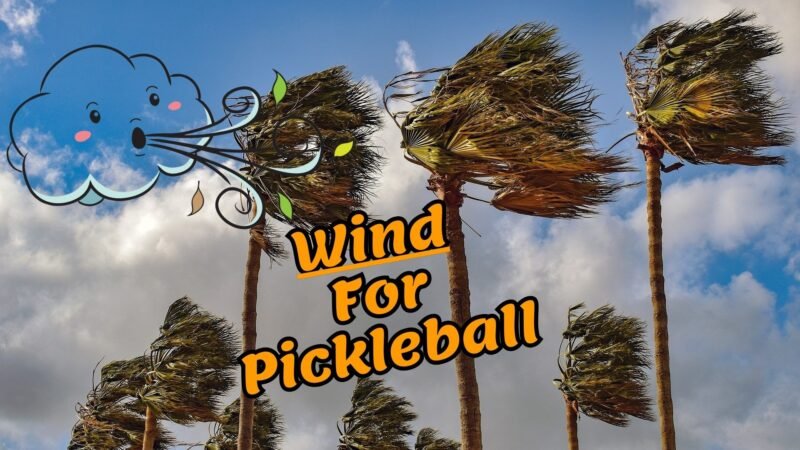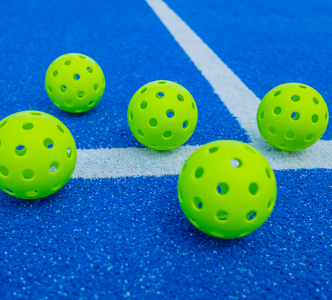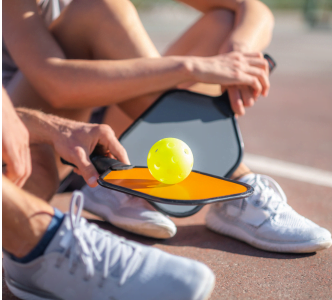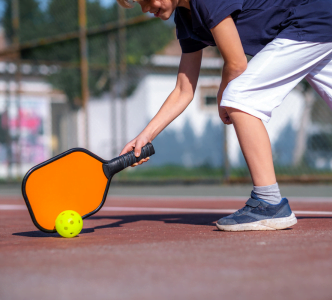Pickleball is a fun game that people of all ages love to play. It’s usually easy to pick up and fast-paced, which makes it a great way to spend time with friends. However, playing pickleball can become complicated when it’s windy outside.
especially in Florida there’s too much wind and hard to play pickleball in the windy days. Wind can change how the ball moves, making the game hard to play and enjoy.
Is it essential to know how much wind is too much for pickleball? In this post, we will talk about how wind affects pickleball and give you some tips on how to play when it’s windy. Whether you’re new to the game or have been playing for a while, you’ll find helpful advice to ensure the wind doesn’t spoil your fun.
How Much Wind is Too Much for Pickleball
The wind can be your best friend or most formidable opponent when playing pickleball. As an avid pickleball player, I’ve experienced firsthand how the wind can dramatically affect gameplay.
The ideal wind for pickleball is light to moderate, typically around 0 to 10 miles per hour. At this speed, the wind is enough to cool you down and keep the game interesting without disrupting the ball’s path too much. It’s all about finding that sweet spot where the wind adds a layer of strategy without becoming overly challenging.
Playing in light wind requires adjusting your playing style. You must anticipate the wind’s direction and adjust your shots accordingly. This means hitting the ball harder when playing into the wind or easing up on your power when the wind is at your back.
The key is to stay adaptable and use the wind to your advantage whenever possible.
Remember, the most skilled pickleball players can quickly adapt to changing conditions, including the whims of the wind.
How Wind Speed Affects Pickleball Play
Wind speed plays a crucial role in pickleball, impacting everything from the ball’s trajectory to players’ strategies. Even the most seasoned pickleball players have to adjust their game when the wind picks up. Let’s dive into how different wind speeds can change how we play this beloved sport.
At low wind speeds (0-5 mph), the effects are minimal, often only slightly altering the ball’s path. This gentle breeze can make the game more enjoyable, cooling players down without significantly affecting gameplay. However, the game changes noticeably as wind speeds increase to moderate levels (5-15 mph). The ball starts to drift, serves become unpredictable, and players must adapt their strategies, often opting for more conservative shots to maintain control.
High wind speeds (above 15 mph) introduce a new level of challenge. The ball’s behavior becomes highly unpredictable, constantly forcing players to adjust their positioning and shot selection. In these conditions, the game becomes more about battling the elements than facing the opponent across the net.
Players must focus on solid and low shots to mitigate the wind’s influence and rely heavily on their ability to read the game and anticipate the wind’s impact on each play. In essence, wind speed transforms pickleball from a game of precision to one of adaptability and resilience.
This is HOW Pickleball Senior Pros Handle Winds at APP Plantation 2nd round
How to know The wind speed while playing pickleball
To play pickleball in windy conditions, there are ways to know the speed of wind:
- Use a weather app
- Observe flags and trees
- Feel the wind
- Use a handheld Anemometer
- Watch the ball
Using a Weather App
Before heading out to play, check the local weather forecast on your smartphone or weather app. These apps often provide real-time wind speed and direction, giving you a heads-up on your playing conditions.
Observing Flags and Trees
Look at the flags, trees, and other loose objects around the court. If flags are lightly fluttering, the wind is likely in the 1-5 mph range, indicating minimal impact on play.
If the trees and flags are noticeably moving, you’re likely dealing with moderate winds around 5-15 mph, affecting the ball’s path. Strong wind movement in trees and flags bending significantly suggests winds over 15 mph, substantially impacting gameplay.
Feeling the Wind
Pay attention to how the wind feels on your skin and clothes. A gentle breeze you can barely think of suggests low wind speeds, while a consistent wind that cools you down and moves your clothing indicates moderate speeds. If the wind is strong enough to make it difficult to walk against or hear over, it’s in the higher range.
Use a Handheld Anemometer
A handheld anemometer can provide accurate wind speed measurements for those who are very serious about their game. This small, portable device can be brought to the court to measure the wind speed directly, giving you precise data to inform your game strategy.
Watch the Ball
During warm-up, pay close attention to the behavior of the ball. Hit a few shots and serve to see how the ball moves. This can give you a practical sense of how the wind will affect play, allowing you to adjust your shots and positioning right from the start.
How Wind Speed Affects Ball Trajectory and Movements

It understands how wind speed impacts ball trajectory, and movements are crucial for any pickleball player, regardless of skill level. When you’re out on the court, it’s not just about how hard or accurately you hit the ball but also about adapting to the wind’s influence.
Wind can significantly alter the path of the ball, making shots unpredictable. For instance, a strong headwind can slow the ball down, reducing its travel distance, while a tailwind can do the opposite, speeding the ball up and potentially causing it to go out of bounds.
Side winds add another layer of complexity, pushing the ball sideways and forcing players to adjust their aim to compensate. This means that what looks like a straight shot could veer off course, requiring quick thinking and adaptability.
Paying attention to the wind’s direction and strength can help players anticipate these changes and adjust their strategies accordingly. It’s about more than just power: precision and planning.
To play effectively in windy conditions, practicing under various wind speeds and directions is essential. This helps players understand how much they need to adjust their aim or the force behind their shots.
Additionally, communicating with your partner about the wind can help you make more brilliant plays. Remember, mastering the wind’s effect on the ball isn’t just about coping with it; it’s about using it to your advantage, turning what could be a disadvantage into a strategic element of your game.
Should You Play Pickleball in Windy Weather?
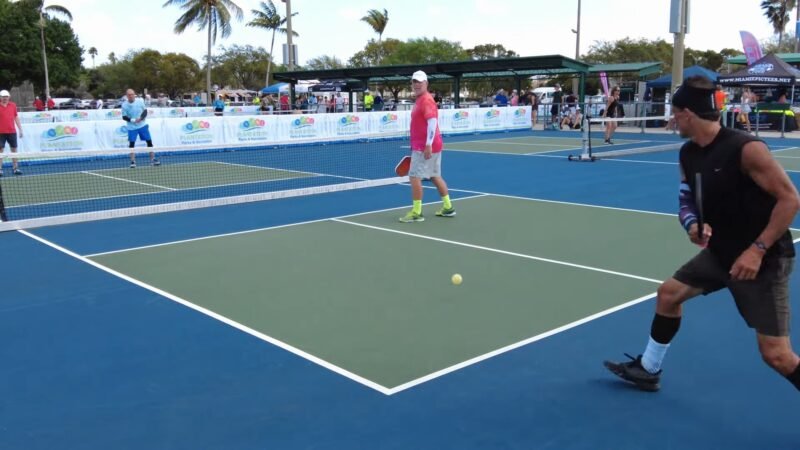
Deciding whether to play pickleball in windy conditions comes down to personal preference and the opportunity for skill development. Windy weather adds an unpredictable element to the game, challenging players to adapt their techniques and strategies.
On the one hand, playing in the wind can be frustrating as it affects ball trajectory and movement, making it difficult to execute precise shots. However, on the other hand, it also offers a unique opportunity to improve your adaptability and learn how to use the wind to your advantage.
For recreational players looking for a fun, casual game, strong winds might detract from the enjoyment. The constant adjustment for wind can make the game feel more about battling the elements than playing against your opponent.
Yet, windy conditions can serve as a valuable training ground for those looking to enhance their skills. It forces players to become more mindful of their shot selection, power, and placement, developing a deeper understanding of the game’s dynamics.
Ultimately, whether you should play pickleball in windy weather depends on your goals for the game. Windy days can provide a great learning experience if you aim to improve and challenge yourself.
However, wait for calmer conditions if you’re seeking a relaxing and straightforward game. Regardless, always ensure safety first and consider the wind’s intensity—extremely high winds could pose risks and take the fun out of the game.
How Wind Affects the Pickleball Player’s Strategy and Movement
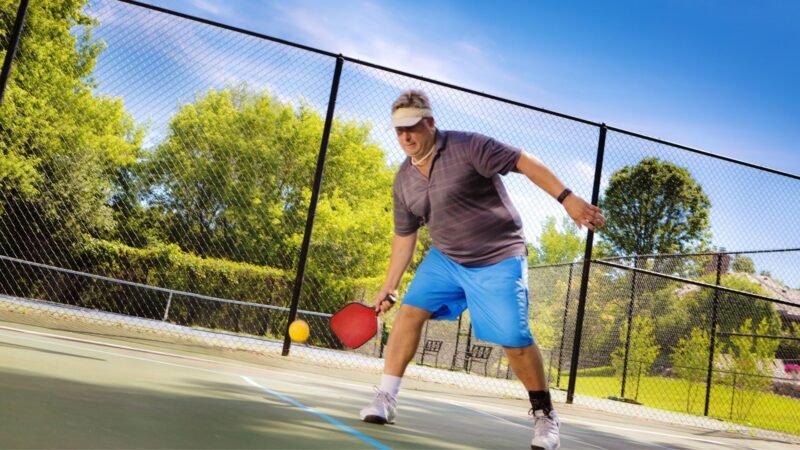
First, wind changes the game from a purely physical challenge to a mental one. When the wind picks up, your usual shots might not land where you expect them to. This means you’ve got to think on your feet, adjusting your aiming points and the force behind your shots.
For instance, if you’re playing in the wind, you’ll need to hit the ball harder than usual to ensure it reaches its intended destination. Conversely, with the wind at your back, a softer touch is required to avoid overshooting.
Moreover, wind affects your movement and positioning. Staying light on your feet and ready to adjust your position is critical in windy conditions. The ball might suddenly change direction, requiring quick lateral movements or sprints forward or backwards.
This unpredictability demands excellent footwork and a keen sense of anticipation. It also means you and your partner (if you’re playing doubles) must communicate even more to cover unexpected changes in the ball’s path.
Lastly, playing in the wind calls for a strategic mindset. You might play a more conservative game, focusing on keeping the ball in play rather than going for aggressive shots.
Or, you could use the wind to your advantage, playing drop shots that the wind will help carry just over the net, making it challenging for your opponents to return. The key is adaptability, adjusting as the game progresses and the wind changes.
The Proven Strategies for Playing Pickleball in Windy Conditions
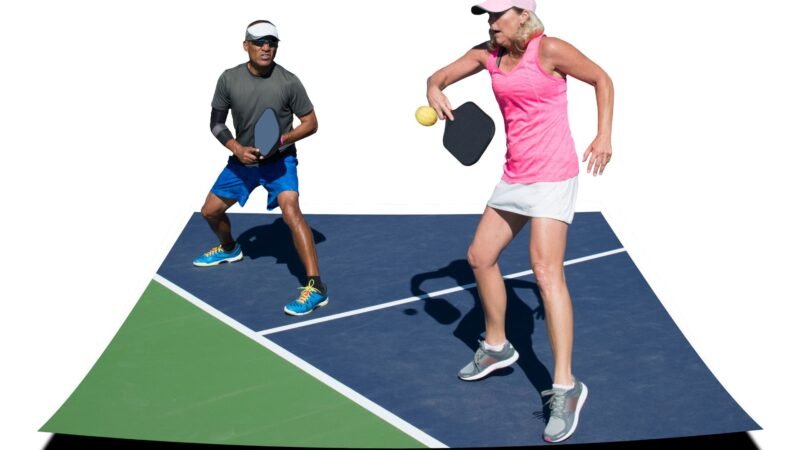
Apply these pickleball tips in windy conditions and you will see a significant change in your game.
Playing pickleball in windy conditions can feel like dealing with an unseen opponent. You can turn the wind from a foe into an ally by adjusting your serving technique, Embracing the high lob, Playing a controlled shot game, adjusting your position, using the wind to your advantage, staying patient and flexible, and communicating with your partner. Here are the details of every strategy
1: Adjust Your Serving Technique
Wind can drastically affect where your serve lands. If you’re serving into the wind, aim lower and hit harder to counteract the wind’s resistance. Are you serving with the wind at your back? Soften your serve to prevent the ball from flying out. Side wind? Serve from the upwind side of the court to let the wind curve the ball into the service box.
2: Embrace the High Lob
A high lob can be a fantastic strategy in windy conditions, especially with the wind at your back. It forces your opponent to make a problematic overhead shot, and the wind can carry the ball further, increasing the difficulty of their return. Be cautious when using this strategy against the wind, as it might cause the ball to fall short.
3: Play a Controlled, Short Game
Windy conditions often call for a more conservative approach. Focus on keeping your shots lower and aim for the middle of the court to reduce the risk of errors. Drop shots and dinks become even more effective as the wind can unpredictably alter the trajectory, making it harder for your opponent to anticipate.
3: Adjust Your Positioning
Anticipate the wind’s effect on the ball and adjust your positioning accordingly. This might mean moving closer to the net when playing into the wind or stepping back when the wind is at your rear. Being adaptable with your court position allows you to handle the erratic movements of the ball better.
4: Use the Wind to Your Advantage
Instead of fighting against the wind, consider how to use it to benefit your play. For instance, a strong side wind can help curve your shots in complex ways for your opponent to predict. Shots that are typically straightforward can become deceptive, adding an extra layer of strategy to your game.
5: Stay Patient and Flexible
Windy conditions require a mindset shift. Accept that the game will be different and that you and your opponent will likely make more unforced errors. Stay patient, keep your frustration in check, and be ready to adapt your strategy as the game progresses.
6: Communicate with Your Partner
In doubles play, communication becomes even more critical in the wind. Talk to your partner about shot selections, who will take the ball, and how you’re adjusting your strategies to deal with the wind. A well-coordinated team can effectively mitigate the wind’s impact.
What Equipment Can Help You to Play in Windy Conditions
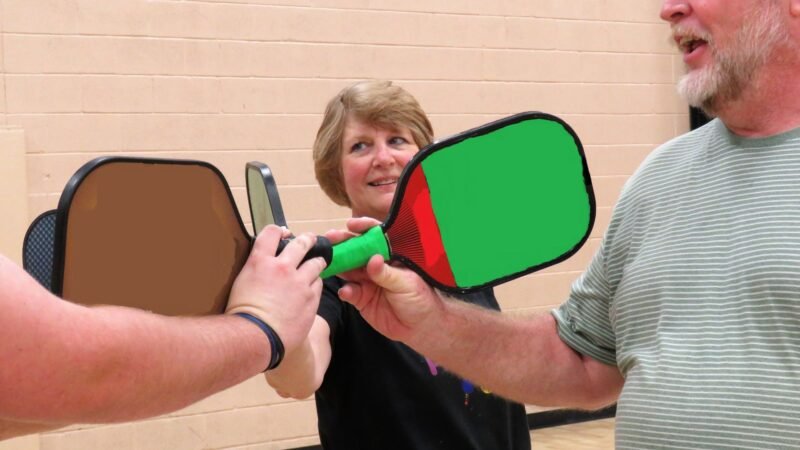
Playing pickleball in windy conditions doesn’t just test your skills and adaptability but also highlights the importance of having the right equipment. The right gear can significantly affect how well you manage the wind. Here’s a rundown of equipment that can help you maintain your edge on windy days:
Heavier Paddles
A heavier paddle offers more stability and control in the wind. While it might sacrifice a bit of speed, the added weight helps keep your shots more consistent and less susceptible to being thrown off by gusts. Look for paddles on the heavier end of the spectrum, typically around 8.5 ounces or more.
Textured Balls
Using a ball with a slightly rougher texture can provide better grip and more predictable flight patterns in windy conditions. These balls are less likely to veer off course and can help maintain the integrity of your shots.
Wind-Resistant Clothing
Believe it or not, what you wear can impact your performance in the wind. Opt for tighter-fitting, aerodynamic clothing that won’t catch the wind and create drag. Lightweight but snug apparel allows for better movement and less interference from the wind.
Quality Shoes with Good Grip
Windy conditions often require quick, unexpected movements and adjustments. A pair of shoes with excellent traction can prevent slipping and help you maintain stability as you hit the ball, ensuring you can respond quickly to the unpredictable nature of windy games.
Sunglasses or Protective Eyewear
On windy days, dust and debris can be a nuisance, potentially impairing your vision at critical moments. A good pair of sports sunglasses or protective eyewear can shield your eyes from the sun and anything the wind might whip up into your face.
Hat or Visor with a Secure Fit
A hat or visor can keep the sun out of your eyes and help you maintain better visibility, but make sure it fits snugly. Losing your hat mid-point can be distracting and even cost you a shot. Look for hats with adjustable straps that can be tightened to withstand windy conditions.
Dampeners for Paddle Handle
While more commonly used to reduce vibration, adding a dampener to your paddle handle can also improve your grip in windy conditions, especially if your hands become sweaty or slippery. A secure grip is essential for controlling your shots when the wind tries to take control of the game.
Safety Precautions for Playing Pickleball in Windy Conditions

Playing pickleball in windy conditions introduces unique challenges and safety considerations. To ensure you enjoy the game without risking injury or accidents, here are some essential safety precautions to keep in mind:
Check the Weather Forecast
Before heading out to play, checking the weather forecast is crucial. High winds can sometimes accompany severe weather conditions like thunderstorms. If there’s a warning for high winds or storms, it might be best to reschedule your game for safety.
Secure Loose Items
Windy conditions can cause loose items to fly, which can be a hazard on the court. Ensure all personal belongings, such as bags, water bottles, and equipment, are securely stored or anchored. This prevents them from becoming airborne and causing injuries or distractions.
Use the Right Equipment
As mentioned earlier, heavier paddles and appropriate clothing can help you maintain control and stability in windy conditions. Moreover, wearing sunglasses or protective eyewear can protect your eyes from debris carried by the wind.
Stay Hydrated and Protected
Windy conditions, especially with sun exposure, can lead to quicker dehydration and sunburn. Make sure to drink plenty of water and apply sunscreen to protect against UV rays. The wind can sometimes make you less aware of getting dehydrated or sunburnt until it’s too late.
Adjust Your Play for Safety
In windy conditions, balls can behave unpredictably, which tempt players to make risky moves to hit challenging shots. Always prioritize your safety over making the shot. Avoid sudden, unsafe movements that could lead to slips, falls, or strains.
Be Mindful of Surroundings
The wind can carry the ball, other objects, or even sand and dust into the playing area. Be aware of your surroundings and the conditions of the court. If the surface becomes slippery with debris, take the time to clean it up before continuing the game.
Listen to Your Body
Playing in windy conditions requires more physical effort and can be more taxing on your body. Pay attention to how you’re feeling and take breaks as needed. If you start feeling tired or dizzy, it’s essential to rest and recover.
Conclusion
Playing pickleball in windy conditions presents a unique set of challenges, but with the right mindset and preparation, it can also be an opportunity for growth and fun. By adjusting your strategies, choosing appropriate equipment, and taking necessary safety precautions, you can navigate the unpredictable elements that wind brings to the game.
So now you understand the wind for pickleball, next time the wind picks up, embrace it as part of the game’s challenge and an opportunity to test your adaptability and strategic thinking on the court. With these tips and precautions in mind, you’re ready to face the wind confidently and enjoy the pickleball game, no matter the conditions.
FAQ’s
When Do Windy Conditions Become Too Challenging in Pickleball?
Windy conditions become too challenging in pickleball when the wind speed exceeds 20 mph. At this point, controlling the ball becomes increasingly difficult, and the game may no longer be enjoyable or safe. High winds can unpredictably alter the ball’s trajectory, making it hard to execute strategic plays or even maintain basic control over the game.
How windy is too windy for pickleball?
Pickleball can be played in mild to moderate wind conditions without significant issues. However, wind speeds above 20 mph can make the game challenging and less enjoyable due to the difficulty in controlling the ball. Safety should always be a priority, and extremely windy conditions might pose risks.
How strong is the 17mph wind?
A 17mph wind is considered moderate and can significantly affect outdoor activities like pickleball. While it’s possible to play in these conditions, players will need to adjust their strategies and expect the ball to behave unpredictably.
How do you play with the wind?
Playing with the wind involves adjusting your shot power and direction to compensate for the wind’s influence on the ball. Serve and hit harder into the wind, and use lighter touches when the wind is at your back. Positioning and movement also become crucial, as anticipating where the ball will go is key.
Can you play pickleball when it is windy?
Yes, you can play pickleball in windy conditions by adapting your game to the wind. This includes modifying your serving technique, playing a more conservative short game, and using equipment suited for windy conditions, such as heavier paddles.
Is 15 mph wind too strong?
A 15 mph wind is on the higher end of what’s manageable for pickleball but still playable. Players will need to adjust their techniques and strategies to accommodate the increased wind speed, focusing on control and anticipation.
Is 7mph wind strong?
A 7mph wind is considered light and should not significantly impact pickleball games. While there might be some effect on the ball’s trajectory, it generally won’t require major adjustments to play style.
What wind speed is too strong?
Wind speeds exceeding 20-25 mph are generally considered too strong for enjoyable or safe pickleball play. At these speeds, controlling the ball becomes exceedingly difficult, and the risk of injury or accidents can increase.

